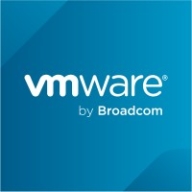

Find out in this report how the two Server Virtualization Software solutions compare in terms of features, pricing, service and support, easy of deployment, and ROI.
With OpenShift combined with IBM Cloud App integration, I can spin an integration server in a second as compared to traditional methods, which could take days or weeks.
Moving to OpenShift resulted in increased system stability and reduced downtime, which contributed to operational efficiency.
It is always advisable to get the bare minimum that you need, and then add more when necessary.
We can say 10% is the approximate amount of savings because most of the things are automated and streamlined, so the manual work is eliminated in most cases.
Red Hat's technical support is responsive and effective.
I have been pretty happy in the past with getting support from Red Hat.
Red Hat's technical support is good, and I would rate it a nine out of ten.
Priority one issues are usually addressed by engineers within one to two hours.
Recently, support has been less friendly and slower, especially after the company was acquired by Broadcom.
If we have issues, the support tends to be unreliable
The on-demand provisioning of pods and auto-scaling, whether horizontal or vertical, is the best part.
OpenShift's horizontal pod scaling is more effective and efficient than that used in Kubernetes, making it a superior choice for scalability.
Red Hat OpenShift scales excellently, with a rating of ten out of ten.
Scaling is easy, whether it is hyperconverged or a three-tier architecture.
VMware vSphere is highly scalable in terms of the number of users and the number of servers it can handle.
It is a highly scalable solution.
It provides better performance yet requires more resources compared to vanilla Kubernetes.
I've had my cluster running for over four years.
It performs well under load, providing the desired output.
It is a very stable hypervisor solution.
While they are generally stable, if outages occur, they tend to be due to brands like HP or Dell, not VMware vSphere itself.
Mostly we don't have issues, but sometimes we have faced some stability issues because of some bugs and some CPU compatibility issues with Intel CPUs.
Learning OpenShift requires complex infrastructure, needing vCenter integration, more advanced answers, active directory, and more expensive hardware.
Red Hat OpenShift's biggest disadvantage is they do not provide any private cloud setup where we can host on our site using their services.
We should aim to include VMware-like capabilities to be competitive, especially considering cost factors.
The cost changed from perpetual to subscription, and there is a need for alternative solutions.
Another area is the stability during upgrades from older versions to newer versions, where we face issues.
Sometimes, it is difficult to find documentation for specific tools and solutions.
Initially, licensing was per CPU, with a memory cap, but the price has doubled, making it difficult to justify for clients with smaller compute needs.
Red Hat can improve on the pricing part by making it more flexible and possibly on the lower side.
The cost of OpenShift is very high, particularly with the OpenShift Plus package, which includes many products and services.
Many customers are trying to avoid it due to its high cost.
Costs significantly increased from perpetual to subscription, with prices rising by two to three times over three to five years.
The solution is too expensive.
Because it was centrally managed in our company, many metrics that we had to write code for were available out of the box, including utilization, CPU utilization, memory, and similar metrics.
The concept of containers and scaling on demand is a feature I appreciate the most about Red Hat OpenShift.
A valuable feature of Red Hat OpenShift is its ability to handle increased loads by automatically adding nodes.
The vMotion feature is beneficial for online migration of virtual machines from one host to another without downtime.
The tool is highly available, which is crucial for implementing critical applications requiring 24/7 availability.
I always use VMware vSphere vMotion; we work with this feature all the time. vMotion is very useful; that's why we use the virtualization.
| Product | Market Share (%) |
|---|---|
| VMware vSphere | 16.8% |
| Red Hat OpenShift | 2.9% |
| Other | 80.3% |


| Company Size | Count |
|---|---|
| Small Business | 17 |
| Midsize Enterprise | 4 |
| Large Enterprise | 40 |
| Company Size | Count |
|---|---|
| Small Business | 174 |
| Midsize Enterprise | 137 |
| Large Enterprise | 256 |
Red Hat OpenShift offers a robust, scalable platform with strong security and automation, suitable for container orchestration, application deployment, and microservices architecture.
Designed to modernize applications by transitioning from legacy systems to cloud-native environments, Red Hat OpenShift provides powerful CI/CD integration and Kubernetes compatibility. Its security features, multi-cloud support, and source-to-image functionality enhance deployment flexibility. While the GUI offers user-friendly navigation, users benefit from its cloud-agnostic nature and efficient lifecycle management. However, improvements are needed in documentation, configuration complexity, and integration with third-party platforms. Pricing and high resource demands can also be challenging for wider adoption.
What are the key features of Red Hat OpenShift?Red Hat OpenShift is strategically implemented for diverse industries focusing on container orchestration and application modernization. Organizations leverage it for migrating applications to cloud-native environments and managing CI/CD pipelines. Its functionality facilitates efficient resource management and microservices architecture adoption, supporting enterprise-level DevOps practices. Users employ it across cloud and on-premises platforms to drive performance improvements.
VMware vSphere is a versatile virtualization platform known for its ease of use, flexibility, and high availability. It supports seamless migration, optimal resource allocation, and centralized management, making it highly suitable for diverse infrastructure needs.
VMware vSphere is widely adopted for its virtualization capabilities that enhance hardware efficiency and ensure minimal downtime through features like High Availability and Distributed Resource Scheduler. Despite criticisms about high licensing costs and limited fault tolerance, it remains a preferred choice due to its stability, scalability, and robust integration options. Users appreciate its efficiency in managing virtual machines and hosting enterprise applications, although challenges with web client performance and hardware compatibility are noted. Organizations often look for better integration with cloud services and enhanced automation and scalability.
What are the core features of VMware vSphere?
What benefits and ROI can businesses look for?
VMware vSphere is implemented across sectors like healthcare, finance, and education for server virtualization, data center management, and private cloud creation. Its use in facilitating business-critical operations ensures high availability and efficient resource use, supporting both development and production environments.
We monitor all Server Virtualization Software reviews to prevent fraudulent reviews and keep review quality high. We do not post reviews by company employees or direct competitors. We validate each review for authenticity via cross-reference with LinkedIn, and personal follow-up with the reviewer when necessary.